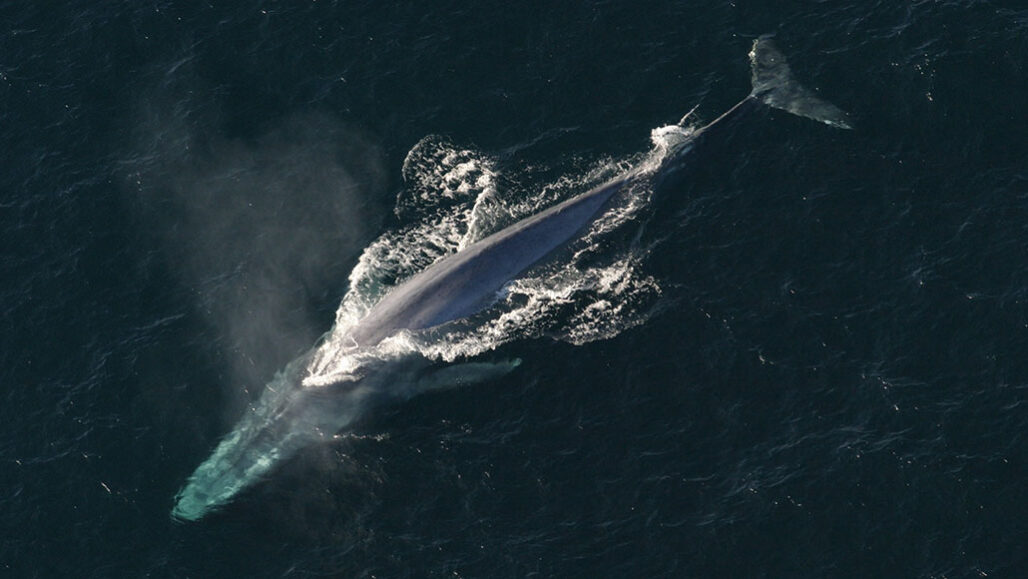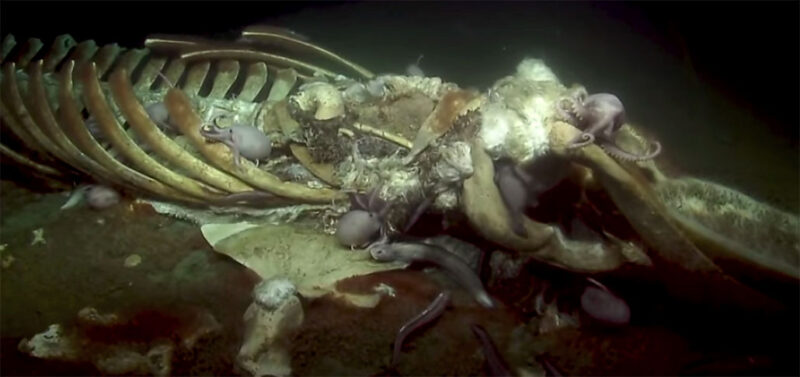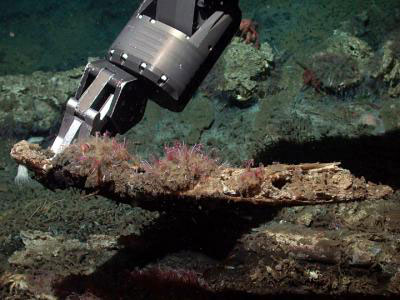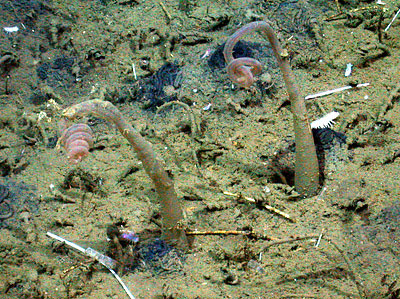Whales get a second life as deep-sea buffets
The carcasses support entire communities of living things found nowhere else on Earth

Blue whales are the largest animals known to have ever lived on Earth and can grow to more than 30 meters (100 feet) in length. When they die and sink, their bodies can provide a feast to smaller organisms.
NOAA
Last October, a team of marine explorers sent Hercules — a remote-controlled vehicle — to the bottom of the ocean. Its mission: to visit an octopus neighborhood. It was off the coast of central California, near an undersea volcano. Late one night, after scanning a long stretch of empty seafloor, Hercules’ spotlight and camera revealed a parade of curious creatures. First was a slender bottom-feeder called an eelpout. It was half-buried in the sediment. Then came a sea pig — a squishy thing that looks like a living pink balloon, but with tentacles.
“And another sea pig and another sea pig,” said Chad King, a marine researcher leading the watch. He works at the Monterey Bay National Marine Sanctuary in California.
“A whole squadron of sea pigs,” added Megan Cook, who runs educational programs for the Ocean Exploration Trust based in Old Lyme, Conn. This research nonprofit ran the expedition.
Together with other researchers, King and Cook were watching on monitors in a boat floating 3,000 meters (1.9 miles) above the seafloor. After the sea pigs, a scattering of octopuses came into view.
At last the rover’s cameras revealed why these creatures — and hundreds, maybe thousands of others — had flocked to this undersea neighborhood. The carcass of a large whale had sunk to the spot near this long-dead volcano. The researchers gasped. They ooh-ed and aah-ed. “Whale fall,” they said, one after another, in excited near-whispers.
For creatures that live in the deep, dark ocean, a whale fall is a gluttonous feast. (“Dinner is served!” shouted one watching scientist. “Come and get it!” answered another.) The all-you-can-eat buffet brings out an exotic parade of creatures of various sizes, shapes and appetites. Think of it as a watery free-for-all: Hagfish, octopods, squid, sharks, crabs and worms all gather and devour. It’s a rich ecosystem all of its own. In deep water, where relatively few animals live, the feast may last for years.
For marine biologists, the body of a dead whale provides an opportunity to study life in one of the least explored places on Earth: the bottom of the ocean.
“Not very much is known about the deep sea, but it makes up most of the biosphere,” says Craig Smith. He is an oceanographer at the University of Hawaii at Manoa. Smith has studied life on the seafloor all around the world. When he talks about the biosphere, he means all the places on the planet where life is found — including the remains of a giant whale. More than 20 types of organisms found on whale falls also have been found in other extreme locations. Those include hydrothermal vents and cold seeps. Both are breaks in the seafloor that release fluids rich in minerals. (The water from vents is hot, and water from seeps is about the same temperature as the sea.) But other creatures seem to show up only when a whale dies.
“There’s a big diversity of animals that appear to live on whale falls,” says Smith, “and nowhere else.”

Here come the snotflowers
Skeletal remains of the whale that Hercules found stretched some five meters (16 feet) from mouth to tail — or what was left of these. Its jaw still had fragments of baleen. That’s a tough material made of keratin. It’s the same stuff that makes up fingernails and hair. Baleen whales don’t have teeth. Instead, they use baleen screens to filter seawater and trap tiny prey, such as krill.
After a whale dies, it has a second life as food for at least 100 known species. Not all the animals come at once. The first to arrive are hungry and ruthless. They are what marine biologists call marine scavengers. These include six-gilled sharks and rattail fish. Their sharp teeth tear flesh off the whale bones. They also may include giant isopods, which burrow into the body. They look like oversized versions of the roly-polies, or pillbugs, that you might find in a garden. Scavenging amphipods, which look like sand fleas, come out in droves.
Marine biologist Robert Vrijenhoek has spent decades studying the sea at California’s Monterey Bay Aquarium Research Institute (MBARI). He calls the scavengers the start of a “feeding frenzy.” Other creatures soon show up. Black hagfish burrow into the carcass to digest it from the inside out. Crabs dance along the bones, scraping and snacking. It’s “like they’re eating corn on a cob,” says Vrijenhoek.
Other scavengers with hard outer shells arrive a bit later. “They sandpaper the bones down,” Vrijenhoek says. All that scraping produces bone dust, which settles on the seafloor like sawdust under a workbench. At the same time, smaller creatures have to watch out. Octopuses, which prey on crustaceans, worms and mollusks, bob in and out of the bones. They’re there to eat the things that are eating the whale.

Once the bones have been picked nearly clean, another phase begins. This is when the mysterious, hungry worms arrive. The scientific name for this group of creatures is Osedax, which in Latin means “bone-eating.” The worms produce an acid that dissolves the hard, outer layer of bone. Then they reach small tendrils into the bone’s center, almost like a plant growing roots. These tendrils devour the rich proteins, like collagen, found inside the bone. To Osedax, those proteins are a means of survival.
The arrival of the Osedax also launches an underwater back-and-forth battle. The crustaceans leave and the worms show up. Then the crustaceans return to try to eat the worms. As the worms retreat into the bones, the crustaceans leave once more. The worms re-emerge, which brings back the crustaceans.
“There’s this remarkable tug of war,” Vrijenhoek says.
Scientists sometimes call the Osedax “zombie worms.” Vrijenhoek led the team of scientists that first found them in 2002. They were feasting on the carcass of a gray whale almost 2,900 meters (close to 2 miles) beneath the surface near Monterey, Calif. Since then, deep-sea observations have turned up at least 30 different species of Osedax worms. And because they produce blobs of mucus, they’re sometimes called “snotworms” or “snotflowers.”
Invasion of the zombie worms
Osedax worms have been found in oceans all over the world. They’ve only ever been spotted on bone, which makes some scientists think that the bone-eaters are specialized to live in odd ecosystems, such as whale falls. “Those kinds of animals are definitely uniquely adapted to the environment in which you find them,” says marine biologist River Dixon. She is a graduate student at the University of Louisiana in Lafayette.
But as recent experiments show, the bone-eaters may not be picky about what type of bones they devour. Last year, biologists spotted Osedax worms in the Gulf of Mexico for the first time. And not on whale bones. Dixon was part of a research team that made the discovery. In early 2019, her group sunk the carcasses of three alligators in water about 2 kilometers (1.2 miles) deep. Over the next few months, they sent a remote-controlled vehicle a few times to spy on what were essentially “alligator falls.”
One had been dragged away. Only a harness and the weights used to keep it down remained. (Dixon suspects a shark was the culprit.) Another had been invaded by giant isopods — those big roly-polies — within a day of being submerged. Dixon says they already had bored their way through the tough alligator hide.
On the third, which the scientists revisited 51 days after they sunk it, “the flesh was gone,” Dixon says. “It had been reduced to just the skeleton.” And just as at whale falls, it hosted a carpet of bone-eating Osedax worms. These worms were similar to other bone-eaters but represented a never-before observed species. That means the scientists who found them get to name it (although Dixon says they haven’t settled on a name yet).
The lab where Dixon works studies food systems in the deep ocean. The food web for most living things begins with the sun. Algae and plants use photosynthesis to turn sunlight into food. Animals eat those plants and algae to survive. Then larger animals may eat those animals.
But sunlight doesn’t reach the deep ocean’s bottom.
“There’s no light. And because there’s no light, there’s no photosynthesis,” says Dixon. “Almost all of the food in the deep sea basically rains down from the overlying waters.” Scientists call this supply “marine snow.” However, the amount of plants and algae that fall don’t provide enough support for the diversity of life found at the bottom, Dixon says. “We study the different pathways for how food can make it to the deep sea.”
These pathways include whale falls and other carcasses, such as when fish or other larger creatures die. (They also include feces.) The scientists in Louisiana chose alligators, Dixon says, because these animals have been found recently in both freshwater and saltwater environments. The scientists wondered how alligator falls fit into a larger food web. To find out, they sunk their own.
Studying alligator falls, Dixon says, could help show how life evolved in the deep sea. “In the ancient oceans, we had things like plesiosaurs and ichthyosaurs — large marine reptiles that dominated the oceans,” she says. It’s possible that the creatures found on whale falls and other falls today, she says, evolved from creatures that hundreds of millions of years ago would have devoured plesiosaur falls.
How to make a whale fall
In the 1980s, Craig Smith wanted to know how creatures on the seafloor got food. But where to look? He thought sunken whale carcasses would be a good place to start.
However, he notes, “It’s hard to find them by luck.” Tens of thousands of whales likely swim in the world’s oceans. Smith says that there should be hundreds of thousands of whale falls on the seafloor. But finding them is another matter. The one discovered in October by Hercules was a lucky accident.
In 1987, Smith led a team that found a whale fall off the California coast. Their report on it a few years later offered the first observations of the wide variety of life found on a downed mammal. Since then, scientists around the world have been documenting the diverse species that thrive in this unusual ecosystem.

Some researchers have even created their own falls. In 2004, a blue whale died and washed up on a beach in downtown Monterey. Spanning about 18 meters (60 feet), it clearly wasn’t full grown. Vrijenhoek saw this carcass as an opportunity. After waiting until high tide, when the whale carcass could float, he and his team tied it to a ship. They dragged the whale out to the ocean, attached some heavy weights — in this case, some old train wheels — and sank the carcass.
They intentionally dropped the whale where it would sink about 1,000 meters (3,300 feet). Scientists also have sunk whales in both deeper and shallower waters. Through these experiments, they’ve learned that whale falls attract different scavengers and other creatures, depending on how deep they land.
Sharks generally avoid the deepest oceans, for example. As a result, those whale falls usually stay intact for years, or even decades. In contrast, whale falls in shallow oceans may vanish within a year or two. At 1,000 meters, the Osedax that appear include different species than the ones that show up at 4,000 meters deep.
Scientists are just beginning to understand what happens in the deep ocean. They suspect zombie-worm larvae drift in the water until they find some whale bones. And even though many species show up only when whales die, recent studies have found some of these zombies on other types of carcasses. “We now know the worms can grow and reproduce on the bones of fish, sea lions, elephant seals, turtles and even pig bones dumped at sea,” Vrijenhoek says. Fish scales, too, might provide collagen.
Researchers also are exploring ways that whaling — hunting whales for food — might affect the deep sea, says Smith, in Hawaii. “It’s clear that whaling has reduced the abundance of living whales,” he says. That means fewer whale falls at the seafloor. And fewer whale falls means fewer feasts for things that live on the sea bottom.
Smith says he’s now trying to determine if human activities, such as whaling, have led to the extinction of any of these unusual creatures.
The science of whale falls is a fairly new field. Vrijenhoek says it only exists — and moves forward — because of curiosity. “I see myself as a nine-year-old boy, turning over rocks and bones, to see what I would find,” he says. “And every time we kick over a rock, we find something new.”







